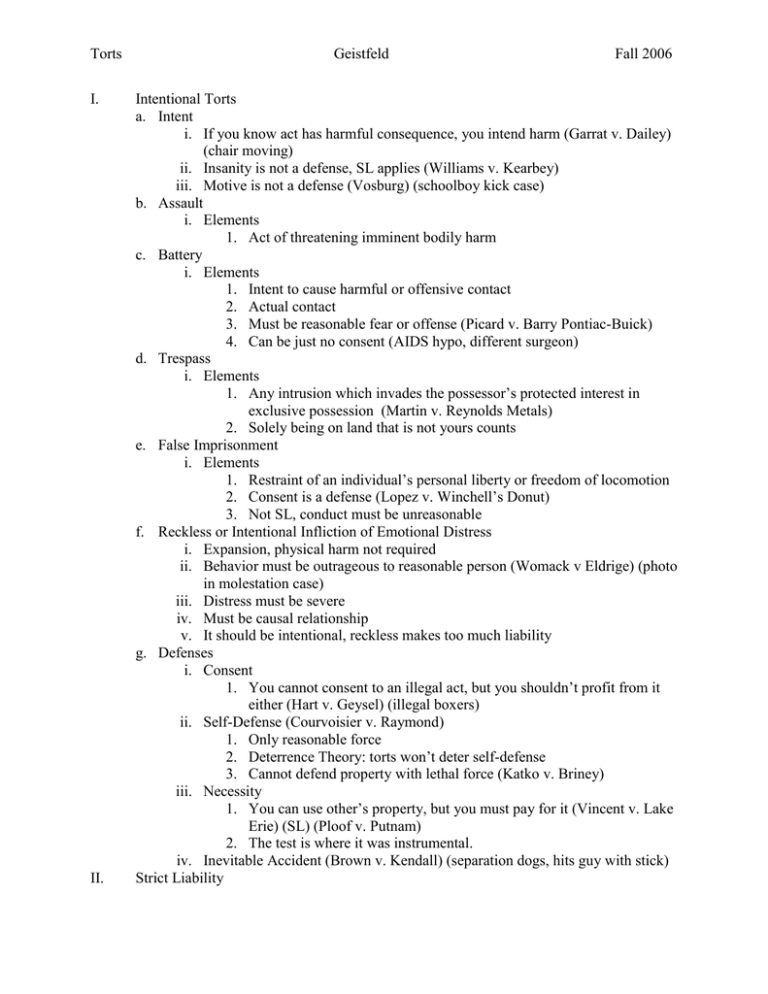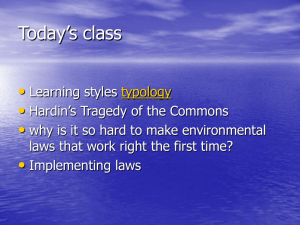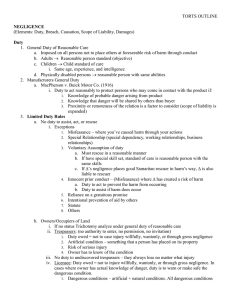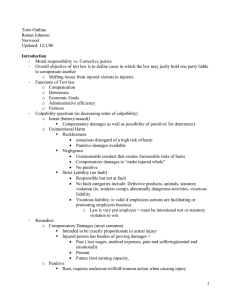Torts Geistfeld ... I. Intentional Torts
advertisement

Torts I. II. Geistfeld Fall 2006 Intentional Torts a. Intent i. If you know act has harmful consequence, you intend harm (Garrat v. Dailey) (chair moving) ii. Insanity is not a defense, SL applies (Williams v. Kearbey) iii. Motive is not a defense (Vosburg) (schoolboy kick case) b. Assault i. Elements 1. Act of threatening imminent bodily harm c. Battery i. Elements 1. Intent to cause harmful or offensive contact 2. Actual contact 3. Must be reasonable fear or offense (Picard v. Barry Pontiac-Buick) 4. Can be just no consent (AIDS hypo, different surgeon) d. Trespass i. Elements 1. Any intrusion which invades the possessor’s protected interest in exclusive possession (Martin v. Reynolds Metals) 2. Solely being on land that is not yours counts e. False Imprisonment i. Elements 1. Restraint of an individual’s personal liberty or freedom of locomotion 2. Consent is a defense (Lopez v. Winchell’s Donut) 3. Not SL, conduct must be unreasonable f. Reckless or Intentional Infliction of Emotional Distress i. Expansion, physical harm not required ii. Behavior must be outrageous to reasonable person (Womack v Eldrige) (photo in molestation case) iii. Distress must be severe iv. Must be causal relationship v. It should be intentional, reckless makes too much liability g. Defenses i. Consent 1. You cannot consent to an illegal act, but you shouldn’t profit from it either (Hart v. Geysel) (illegal boxers) ii. Self-Defense (Courvoisier v. Raymond) 1. Only reasonable force 2. Deterrence Theory: torts won’t deter self-defense 3. Cannot defend property with lethal force (Katko v. Briney) iii. Necessity 1. You can use other’s property, but you must pay for it (Vincent v. Lake Erie) (SL) (Ploof v. Putnam) 2. The test is where it was instrumental. iv. Inevitable Accident (Brown v. Kendall) (separation dogs, hits guy with stick) Strict Liability Torts III. Geistfeld Fall 2006 a. Abnormally hazardous activities i. Starts as using land for non-natural purposes (Rylands v. Fletcher) ii. Losee changes to negligence iii. Resolves as SL for abnormally hazardous activities 1. If you use land in an uncommonly risky way, you are liable (Sullivan v. Dunham (blasting hurts passerby) iv. Six-factor test (Restatement Second) 1. High risk to others’ persons, land, or chattels 2. Big possible harm 3. Cannot eliminate risk using reasonable care (chemicals) 4. Activity is uncommon 5. Activity is inappropriate to place 6. Danger outweighs value to community (boiler) v. If reasonable care doesn’t mitigate, isn’t that negligent in itself? (American Cyanamid) vi. Comes down to nonreciprocal risks are SL b. Rationale i. Burden < Probability of Liability x Cost of Liability ii. Used when it would be hard to prove negligence (evidentiary rationale) iii. Reciprocal risks v. Deterrence iv. Negligence is most efficient in deterring reciprocal risks, SL in non-reciprocal 1. Hammontree v. Jenner (driving is reciprocal, uses negligence) Negligence a. Duty i. You have a duty not to actively create risks, and to control them if you do create them. ii. Special relationship can incur duty 1. Risk must be foreseeable 2. Plaintiff must be deprived of ability to protect himself (Harper v. Herman diver case) 3. Special case: Relationship can be with P or D, duty even when not actively creating a harm (Tarasoff) iii. Non-negligent injury iv. Non-negligent creation of risk (knock down a tree on road, must do something about it) 1. Test (Randi W. v. Muroc Unified School District) (duty to 3rd parties you know can be harmed by false information) a. Foreseeable harm b. Causality c. Public Policy d. Availability of Insurance 2. Negligent Entrustment (Vince v. Wilson) v. No duty to rescue, just to not make things worse 1. If you attempt rescue, you must use reasonable care and leave person in better circumstance (Farwell v. Keaton) (not getting medical care for beat-up person while driving around with him) Torts Geistfeld Fall 2006 2. There must be reasonable reliance to create duty to protect (Riss v. City of NY) (lye stalker case) vi. Some prioritizing of risk 1. Insurance changes analysis a. If liability would just be passed on to customer/Ps, it’s insurance b. Liability is limited if it would leave the world worse than without (Strauss v. Washington) 2. No duty if no control over risk (Pulka v. Edelman) (garage not liable for cars exiting) 3. If reasonable care won’t help, no liability (Reynolds v. Hicks) (wedding minor alcohol case) 4. Limitations a. Where it’s better addressed elsewhere (allocation of government resources) b. Where liability doesn’t help the victim class vii. Emotional Harms 1. Full damages when it comes from a physical injury 2. Also full damages when it causes a physical injury (Falzone v. Busch) 3. No damages for pure emotional harm as public policy, want the money to be there for those actually physically harmed 4. Damages allowed emotional harm is foreseeable and there are no physically injured. (leg given to family) 5. 4-part test (Portee v. Jaffee) a. P is in “zone of danger” b. P saw the accident c. P and victim are closely related d. Injury must be death or serious body harm viii. Economic Harms 1. You are only liable to classes you knew would be relying on your work. (Nycal v. KPMG) 2. Must have physical damage, limiting factor (Madison Avenue) 3. Pure economic loss is not recoverable ix. Wrongful Life and Birth 1. Split in courts, usually limited to expense of birth b. Reasonable Care i. P has to show a reasonable un-taken precaution (Adams v. Bullock) ii. Minimal standard is B < PL (Carroll Towing) iii. There is basically SL for the difference between general reasonable person and the actual person (Bethel v. NYC Transit Authority) (reciprocity, social value of the activity) iv. The handicapped, kids are held to subjective standards based on their reasonable v. Courts or legislatures can establish a specific standard of care (guy crossing railroad), but it usually returns to reasonable person (Pokora) Torts Geistfeld Fall 2006 1. Juries can decide whether to follow a customary standard or not (Andrews v. United Airlines) vi. A prevailing custom establishes a minimal standard, but is not a defense (Trimarco v. Klein) vii. Violating a statute is negligence, establishes a minimal standard (Martin v. Herzog) (lights on a buggy) viii. If violating the statute would create more risk, it’s not negligence (Tedla v. Ellman) ix. If B(pens) < PL(disease) according to statute, then B(pens) must be < PL(disease + washing overboard). (Gorris v. Scott) x. If you can prove that there was reasonable notice to correct a hazard, the jury can decide that not correcting it was negligent (Negri v. Stop and Shop), but not if you can’t prove the reasonable notice (Gordon v. American Museum) xi. Res ipsa loquitor: If more likely than not the harm can’t ordinarily occur without negligence, and D had sole control of the act, that is proof enough to shift the burden to D. (wayward wheels, barrel falling out of window) xii. Medical Malpractice 1. Expert custom provides the standard 2. The reasonable doctor is a national, practice-wide standard (Sheeley v. Memorial) 3. Informed consent is required c. Causation i. Cause in fact 1. If P can show that one cause more likely than not caused the harm, D has to prove it didn’t. (typhoid water) 2. If P can prove that but for the negligence, the harm wouldn’t have happened, D has to prove otherwise. (drug overdose) 3. Lost opportunity – must prove a reasonable certainty that the negligence lessened chances of a good outcome, can only get damages for proportion of liability ii. Multiple defendants 1. Where there is a discreet group, P doesn’t have to show specific causation, D has to disprove it. (hunters) 2. National market share – DES cases, must join the majority of the tortfeasors, need fungibility, duty, breach, casual link 3. Just like “more likely than not”, except against a group instead of one D 4. Alternative liability – must join all the Ds iii. Proximate Cause 1. “But for” connection 2. Eggshell plaintiff- as long as there is some link between the act and the harm, the extent of damages must not be foreseeable 3. If some harm was foreseeable, and a different harm is directly caused, the actor is liable. (falling board) 4. The type of risk must be the same as foreseeable (Wagon Mound) 5. Indirect harms must be foreseeable. Torts Geistfeld Fall 2006 6. Proximate cause must be to a foreseeable person within a “range of apprehension (Palsgraf) 7. Once a foreseen harm has happened, unforeseen but direct harms are still liable. (Kinsman) IV. d. Defenses i. Contributory Negligence 1. Comparative fault – joint and several liability 2. If the D had one “last chance” to act right, P’s original fault doesn’t matter. (drunk driving and malpractice) 3. Now not so much the joint and several ii. Assumption of Risk 1. The risk you assume must be one you have notice of. (ski resort) 2. If P’s B was > PL, there is no negligence of the D (amusement park ride) 3. If D was more negligent than P, P can recover a percentage. (stairs with no lights) 4. Express is contractual, means you’ve decided B > PL. 5. Implied is primary (a reasonable person thinks the B > PL so takes the risk) or secondary (B < PL, P does it anyways) 6. Firefighter’s rule – property owners just have to not willfully injure a firefighter Products Liability a. There is a duty to everyone reasonably foreseen to be in danger. b. If the product is inherently dangerous, the user must be in privity. c. Duty to warn of any defect that would affect a reasonable consumers’ decision making d. You can get SL by proving nothing else could have caused the harm. e. Manufacturing i. Pretty much all SL, because the evidence is really hard to show ii. A defect frustrates the safety expectations of a reasonable consumer iii. Negligence with res ipsa loquitor is basically SL iv. Must be “more likely than not” f. Design i. Reasonable user expectations – usually lower threshold, cannot use experts ii. Risk/benefit analysis- actual expectations, maximizes consumer welfare iii. P has to show reasonable alternative designs g. Warning i. Reasonably foreseeable risks that aren’t common knowledge ii. Warn the ordinary consumer iii. Include risks from ordinary uses of product, not just intended one iv. Design should be safe as possible, warnings are above that v. Heeding presumption – D has to prove P wouldn’t have heeded a warning vi. Learned intermediary doctrine 1. Warning the doctor is the same as warning the patient 2. Except in mass immunizations and FDA mandated warnings Torts V. Geistfeld Fall 2006 vii. You only have to warn of reasonably known risks to an expert (breast implant case), including indicators of possible health risks h. Defenses i. Comparative fault – P must use reasonable ordinary care, or he is part negligent (gear shift) ii. No liability where a third party intervened to change the product (had crushed in no guard machine) iii. Must warn of the dangers of modification (meat grinder) iv. There is no SL if the essence of the transaction is services (prosthetic), mostly medical v. No damages for purely economic loss (steamships) Damages a. Compensatory i. Appeals can only overturn if it “shocks the conscience” ii. You can only get pain and suffering if you can feel pain. iii. Wrongful death you get the lost worth of estate or loss of life’s pleasures b. Punitive i. Degree of reprehensibility ii. Difference between civil penalties and award iii. No more than a single digit ratio between compensatory and punitive iv. Can cover the difference between estimated PL for death and compensatory damages v. Cover conscious disregard of P’s right to reasonable care, where B < PL was disregarded totally vi. First disgorge the profits (if there’s a 1 in 10 chance, they should pay all 10 chances of profits), then deter disregard c. You can get compensation even though collateral sources (insurance, charity) will also reimburse (Arambula) d. You must have a subrogation clause to get it e.









